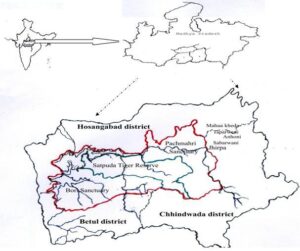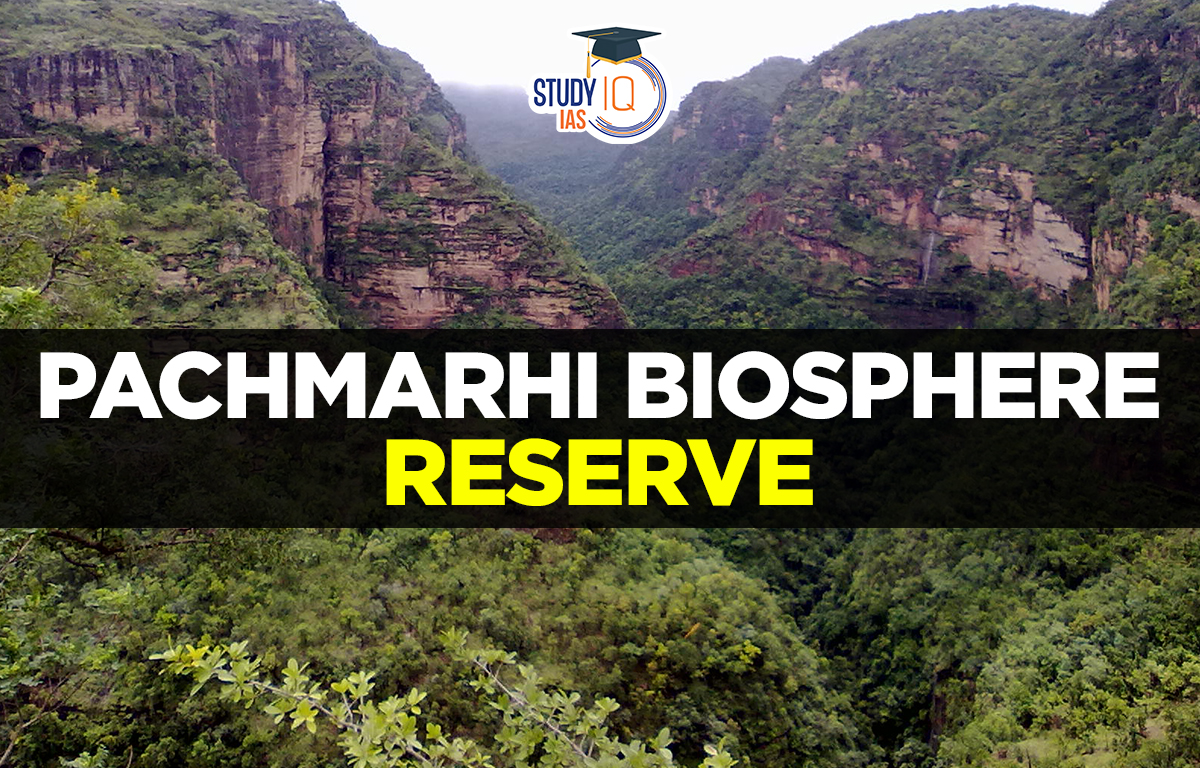Table of Contents
Pachmarhi Biosphere Reserve
Pachmarhi Biosphere Reserve is a protected area located in the Satpura Range of Madhya Pradesh, India. It was established in 1999 and covers an area of 4,926 square kilometers, making it the largest biosphere reserve in Madhya Pradesh. The reserve is home to a diverse range of flora and fauna, including over 1,000 plant species, 50 mammal species, and 250 bird species.
Pachmarhi Biosphere Reserve is also known for its rich cultural heritage and is home to several tribal communities, including the Baiga, Gond, and Korku tribes. These communities have a deep understanding of the local ecology and have been living sustainably with nature for generations.
Read about: Biosphere Reserves in India
Pachmarhi Biosphere Reserve Map
Pachmarhi Biosphere Reserve is located in the Satpura Range of Madhya Pradesh, India. Here is a map of Pachmarhi Biosphere Reserve.

Read about: Nilgiri Biosphere Reserve
Pachmarhi Biosphere Reserve Climate
Pachmarhi Biosphere Reserve has a subtropical climate characterized by hot summers and cool winters. The average temperature during the summer months (March-June) ranges from 25°C to 42°C, while during the winter months (November-February), the temperature can drop to as low as 4°C.
The monsoon season (June-September) brings heavy rainfall to the reserve, with an average annual rainfall of 1,400-1,800 mm. The monsoons make the reserve lush and green, with several waterfalls and streams coming to life.
The best time to visit Pachmarhi Biosphere Reserve is from October to June when the weather is pleasant, and the reserve is teeming with wildlife. During this period, the temperature ranges from 10°C to 25°C, making it an ideal time for trekking, wildlife safaris, and exploring the local tribal culture.
Read about: Major Ports in India
Pachmarhi Biosphere Reserve Vegetation
The vegetation of Pachmarhi Biosphere Reserve can be classified into three main types:
| Vegetation Type | Description |
| Tropical Moist Deciduous Forests | These forests cover the lower regions of the reserve and are characterized by trees such as teak, sal, and bamboo. The forest floor is covered with a rich carpet of grasses, shrubs, and climbers. |
| Tropical Dry Deciduous Forests | These forests cover the middle regions of the reserve and are dominated by trees such as tendu, bija, and saja. The forest floor is covered with dry leaves during the winter months. |
| Montane Forests | These forests cover the upper regions of the reserve and are characterized by trees such as chir pine, deodar, and oak. These forests are more open than the lower-altitude forests and are home to several species of birds and small mammals. |
Apart from these three types of forests, the reserve also has a number of grasslands, shrublands, and wetlands, each with its own unique set of plant species.
Read about: Bandhavgarh National Park
Pachmarhi Biosphere Reserve Fauna
The fauna of the Pachmarhi Biosphere Reserve is diverse and includes a wide variety of mammals, birds, reptiles, amphibians, and insects. Here are some of the notable species found in the reserve:
| Fauna | Description |
| Mammals | Pachmarhi Biosphere Reserve is home to several species of mammals, including tigers, leopards, sloth bears, Indian giant squirrels, barking deer, sambar deer, and wild boar. |
| Birds | The reserve is a bird watcher’s paradise and is home to over 300 species of birds, including the Indian pitta, Malabar pied hornbill, yellow-billed blue magpie, and rufous-bellied eagle. |
| Reptiles and Amphibians | The reserve is also home to several species of reptiles and amphibians, including the Indian rock python, common krait, Indian cobra, Indian star tortoise, and the Malabar gliding frog. |
| Insects | The reserve has a rich diversity of insects, including several species of butterflies, moths, and beetles. |
The diverse fauna of the Pachmarhi Biosphere Reserve is a result of the varied habitats and vegetation types in the reserve. The reserve provides a safe and protected habitat for several threatened and endangered species and is an important site for conservation efforts.
Read about: Kanha National Park
Pachmarhi Biosphere Reserve Tourism
Pachmarhi Biosphere Reserve is a popular tourist destination in India, known for its beautiful forests, waterfalls, and scenic views. The best time to visit Pachmarhi Biosphere Reserve is from October to June when the weather is pleasant and the forests are lush and green.
During the monsoon season, which lasts from July to September, the reserve receives heavy rainfall, which can lead to landslides and road closures, making it difficult for visitors to explore the area. The winter months, from November to February, can be quite chilly, with temperatures dropping to as low as 5°C, but the clear skies and crisp air make for stunning views of the surrounding hills and valleys.
Tourists can enjoy a range of activities in Pachmarhi Biosphere Reserve, including hiking, trekking, wildlife safaris, and sightseeing. The reserve is home to several scenic spots, including the Bee Falls, Apsara Vihar, and Pandava Caves, which offer breathtaking views of the surrounding forests and valleys.
Read about: List of Elephant Reserves in India
Pachmarhi Biosphere Reserve UPSC
Pachmarhi Biosphere Reserve is an important topic for the UPSC (Union Public Service Commission) Syllabus, the Environment and Ecology part. The exam may include questions related to the geography, climate, flora and fauna, and tourism of the reserve.
You can check out the official StudyIQ UPSC Online Coaching website to gain a better understanding of how to prepare effectively for the UPSC exam. Also, the official StudyIQ UPSC online coaching website provides the opportunity to practice UPSC Mock Test for Prelims 2023, which can help you assess your level of preparedness for the exam.
Read about: Tiger Reserves in India


 Repo Rate and Reverse Repo Rate, Impact ...
Repo Rate and Reverse Repo Rate, Impact ...
 Foreign Contribution Regulation Act (FCR...
Foreign Contribution Regulation Act (FCR...
 Urban Cooperative Banks in India, Functi...
Urban Cooperative Banks in India, Functi...





















